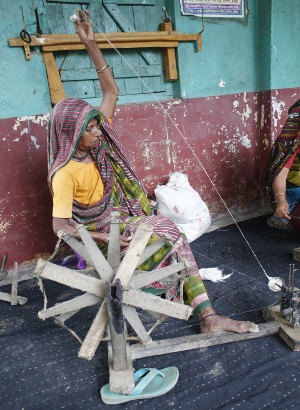Process and Techniques

Spinning yarn on the ‘charka’ in Chandina, Cumilla, Bangladesh
Cotton manufacture was first introduced into Persia and Egypt, and thence into Europe from the Indian sub-continent. Throughout the sub-continent, the art of spinning and weaving cotton fabrics was practiced from remote antiquity; however, it was in Bengal that it reached its supreme height. The process of manufacturing muslin was arduous, complex and lengthy. It was a process that had evolved with clearly defined and customary roles, i.e. while women mostly spun the yarn, the weavers were men. Interestingly, this is often the case to this day.
Professor Karim, writing in 1963, asserts that ‘Karpas though grown in most parts of Bengal, the most appropriate, i.e. ‘phuti karpas’, to weave muslin was found in places near Dhaka’.
Once the bi-annual cotton had been harvested the cotton was cleaned manually, using a boal (large eel-like fish) jaw, a dhun (stringed bow) and board with rolling pin. Seeds were retained for the next cultivation in a terracotta bowl that was hung at head height over the kitchen fire
After cleaning the phuti karpas, the finest thread was spun by women on the takwa (a single, verticle spindle) tending to be between 18 to 30 years of age. Spinning was done in the early morning or late afternoon when the air was more humid and would allow the cotton filaments to stretch. On occasions, in rooms where spinning was done, water bowls would be placed to increase the humidity.
The loom would be readied with two round beams and the warp (long side) yarn is passed from one beam to the other through a fine shana (reed). A secondary weft thread is used to weave the motifs on the cloth, using a maku (hand-held pick). It took months, using this discontinuous weft technique, to create the jamdani motifs directly onto the cloth. Over time another masterpiece rolls off the loom, ready for royal use.
Most of the fine and luxury quality muslins exported by the East India Company to Europe were from the Dhaka region. During the 1780s, muslin was the single largest revenue earner for the company.
– from an old verse prevalent among the farming community.


